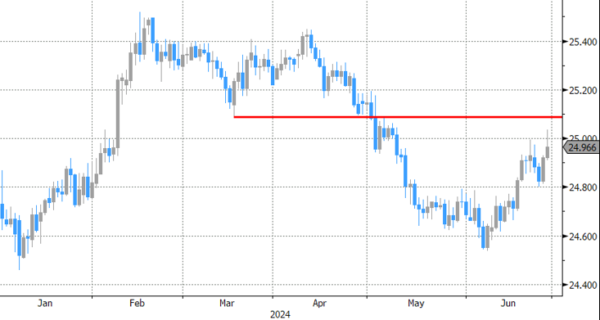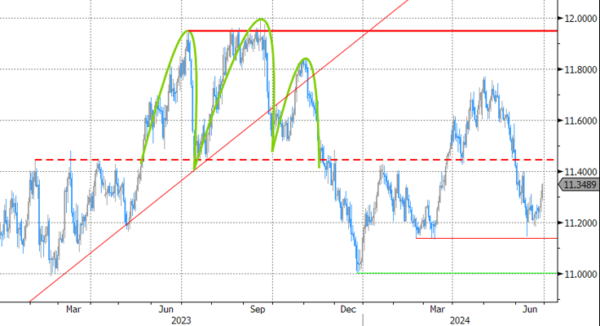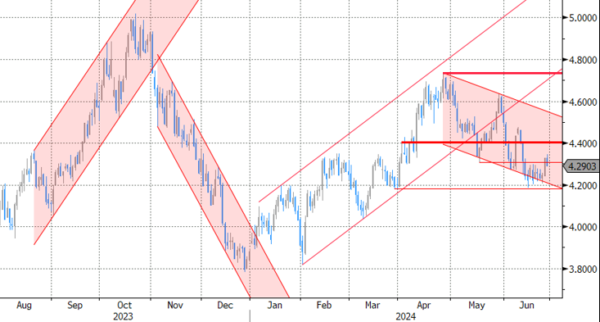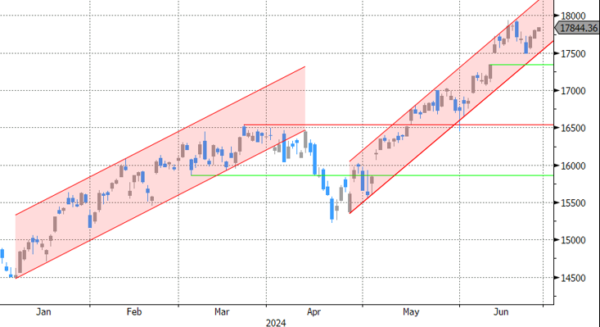Markets
No follow-through price action on yesterday’s rise in long-term yields for now. We at least partially attributed the move to investors’ pondering issues of long-term fiscal sustainability in Europe but also in the US. The Biden-Trump presidential debate later today might provide some additional insights on how much (or how little) priority both candidates are prepared to give to this key policy topic. In the meantime, US eco data today printed rather soft. May durable goods orders showed a lackluster picture (+0.1% M/M after +0.2% in April). Capital goods shipments nondefense ex aircraft, unexpectedly declined 0.6% M/M, indicating potential poor investment growth in Q2. US initial jobless claims declined slightly from 239k to 233k, but continuing claims (1839k) rose to their highest level since end 2021. Recently some Fed governors were on alert that the labour market might be heading for a turning point and that an unexpected softening in labour market conditions also might have consequences for monetary policy as the Fed targets both price stability and maximum employment. US yields currently decline 3 to 4.5 bps across the curve. EMU yields also felt some mild spill-over from the decline in the US, but German yields currently show changes of less than 1 bp across the curve. ECB speakers (Kazaks and Kazimir) both indicated the higher than expected wage growth as an important factor preventing faster ECB rates cuts. The focus on interest rate markets now mainly turns to tomorrow’s US May PCE deflators and the first June CPI estimates in some EMU members states. US equites open marginally higher despite some negative tech-related headlines yesterday. The Eurstoxx 50 is trading little changed. Brent oil ($ 86,2/b) continues to test the strongest levels since early May.
Softer US data cause the dollar to return most of yesterday’s gain. The DXY index fails to hold above the 106 big figure (105.75). EUR/USD rebounded from opening levels near 1.068 to currently 1.0725. The broader dollar correction only provides very limited relief for the yen. At 160.45, USD/JPY still trades within reach of multi-year peak levels. Sterling also underperforms the euro with EUR/GBP coming within reach of first minor resistance at 0.8475.
News & Views
The Swedish Riskbank kept its policy rate unchanged at 3.75% following an inaugural 25 bps rate cut in May as the Board considers that monetary policy should be adjusted gradually. If inflation prospects remain the same, two or three additional rate cuts can be expected in H2 2024. The Riksbank convenes 4 times over that time span with the next gathering being on August 20 (August or September; November and/or December based on current expected path). Swedish inflation is close to the 2% target and economic activity is weak. Updated CPIF forecasts plot average inflation below 2% in both 2025 (1.8% from 1.9%) and 2026 (1.9% from 2%). Together with a little stronger Swedish krone (though still undervalued according to governor Thedeen), this triggered a small downward adjustment to the policy rate path: 3.33% quarterly average in Q4 2024 (from 3.44%), 3.08% in Q1 2025 (from 3.2%) and 2.67% in Q2 2026 (from 2.7%). The Swedish krone underperformed following the central bank’s dovish hold. EUR/SEK rises from 11.30 towards 11.35.
The Turkish central bank went for a similar policy rate status quo, but obviously at a completely different level. Its key rate is stable at 50% for a third month straight. The MPC reiterates that the tight monetary policy stance will be maintained until a significant and sustained decline in the underlying trend of monthly inflation is observed, and inflation expectations converge to the projected forecast range (underlying inflation reaching 5% in the medium term). Upward inflation risks remain and warrant the hawkish tightening bias. It is prepared to use all the tools at its disposal (also liquidity measures). The TCMB is nevertheless hopeful that disinflationary forces will be established in H2 2024 as the lagged effects of monetary tightening kick in. Ever since reaching the 50% (peak) rate, EUR/TRY trades sideways near all-time highs, between 34.50 and 35.50.
Graphs
EUR/CZK: koruna declines (albeit modestly) as CNB maintains 50 bps rate cut pace rather than slowing to 25 bps step

EUR/SEK :Swedish krona cedes ground as Riksbank sees room for two to three 25 bps rate cuts in H2

US 10-yr yield: Long-term yields, for now, fail to build on poor fiscal outlook

Nasdaq to try new test of all-time top after recent correction?.










